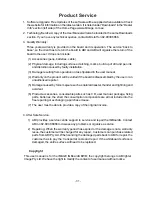
b. Line Functions:
(6th & 7th icons).
Both line icons have the same
sub-bar icons: 7 x colour defaults; 3 x line thickness defaults, 2 x colour density & arrow
defaults. Each line can save its respective defaults.
Line:
You can choose the thickness, colour, transparency and arrow effect of lines.
Double clicking the “
Solid Line
”
button sets the defaults for the line.
Dashed Line:
You can choose the thickness, colour, transparency and arrow effect of
dashed lines. Double clicking the “
Solid Line
”
button sets the defaults for the line.
c. Shape Functions:
(8th to 10th icons).
All shape icons have the same
sub-bar icons: 7 x colour defaults; 3 x line thickness defaults, 2 x colour density
defaults, and a solid fill colour (use colour defaults). Each shape can save its respective
defaults.
Circle:
You can choose the thickness, colour, transparency and arrow effect of circles.
Double clicking the “
Circle
” button sets the defaults for the circle. After selecting the
“
Circle
” button, select a point on screen and drag to create a circle, its size and shape is
changed accordingly by your dragging.
Square:
You can choose the thickness, colour, transparency and arrow effect of
squares or rectangles. Double clicking the “
Square
” button sets the defaults for the
circle. After selecting the
“
Square
” button, select a point on screen and drag to create a
square or rectangle, its size and shape is changed accordingly by your dragging.
Rubber Line: If you want to create a geometrical shape or a zigzag line, you can use
“
Rubber Line
”. Click the “
Rubber Line
”, select a point on screen as the start point of
the first line, and select another point as the end point of the first line (which is also the start
point of the second line), then select the end point of the second line, and so forth, ……
Until you have created a geometrical shape or a zigzag line.
d. Table:
(4th last icon) You can choose the thickness, colour, transparency of the
table frame, as well as the column and row number. After selecting the
“
Table
” button,
select a point on screen and drag to create a table, its size and shape (width of column
and row) will change according to the defaults. To change the defaults, double click on the
table icon, and set the number of rows & columns. Click on the top right properties triangle,
then the bottom “attributes” tab, to display the table layout into which you can type the table
data, or hyperlink to relevant file.
e. Fill
:
(3rd last icon) You can fill colour or gridded pattern (such as cross bar, column
bar,
slanted
bar grid, etc) in any closed geometrical shape and table.
The first 4 icons are colour icons, the fifth is a “no fill” icon, the next 6 are grid pattern icons,
and the last is a picture fill (insert picture) icon. To change the defaults where possible,
double click on the lower row icon.
- 17 -











































